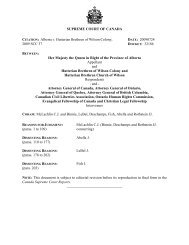Canada (Attorney General) v. Bedford, 2012 ONCA ... - York University
Canada (Attorney General) v. Bedford, 2012 ONCA ... - York University
Canada (Attorney General) v. Bedford, 2012 ONCA ... - York University
You also want an ePaper? Increase the reach of your titles
YUMPU automatically turns print PDFs into web optimized ePapers that Google loves.
Page: 85[206] Given the importance of the legislative objectives that animate the bawdyhouseprovisions, the impact on prostitutes would have to be extreme to warranta finding of gross disproportionality.In our view, on the facts found by theapplication judge, the impact on prostitutes is extreme. While empirical evidenceis difficult to gather, as we have said earlier, there is a body of evidence tosupport the application judge‟s findings.[207] In particular, the evidence in this case suggests that there is a very highhomicide rate among prostitutes and the overwhelming majority of victims arestreet prostitutes. As well, while indoor prostitutes are subjected to violence, therate of violence is much higher, and the nature of the violence is more extreme,against street prostitutes than those working indoors. The bawdy-houseprovisions prevent prostitutes from taking the basic safety precaution of movingindoors to locations under their control, which the application judge held is thesafest way to sell sex. In this way, as the application judge found, the provisionsdramatically impact on prostitutes‟ security of the person. 99 While we do not place a great deal of weight on the international experience, we note that this evidencesupports the respondents‟ position. This evidence shows that legalization and regulation of prostitutionhas increased the safety of prostitutes with minimal increase in the harm a bawdy-house prohibition ismeant to address. The appellants read the evidence from other jurisdictions differently; they suggest thatthe evidence shows that the demand for prostitution increases with decriminalization, that organizedcrime continues to be involved, and that decriminalization does nothing to address the problems of childprostitution. The evidence relied upon by the appellants is unpersuasive and does not meet the evidencerelied upon by the respondents. The appellants‟ evidence rests upon the proposition that prostitution canand should be eliminated, an objective that is not supported by the legislative history of the challengedprovisions.
















